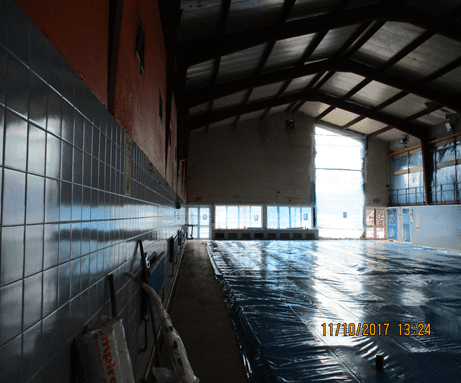& Social Club, 247 Bells Lane,
Hoo, Rochester ME3 9J
CONTRACT COMPLETION DATE 1st December 2017
A National Housebuilder purchased land at the top of Bells Lane in Hoo, previously occupied by the BAE Sports & Social Club, closed since 2014. Bellway Homes Limited proposed to demolish existing buildings and structures and redevelop the land to provide 232 residential units in buildings of up to 3 storeys, together with associated access, landscaping and open spaces.
Existing buildings and structures comprised of the existing Sports & Social Club complex with enclosed swimming pool, a bowling green, club house, tennis courts, car parking and landscaping. The site is bound by the Ratcliffe Highway to the north, adjacent residential development to the south, agricultural land to the north east, and dense vegetation surrounding a neighbouring residential dwelling to the south western boundary.
Dorton Group secured the contract through competitive tendering. The scope of works included:
- The safe removal of all asbestos contaminated materials.
- Soft strip and demolition of all buildings on site except the bowling green which was to be retained. Demolition included breaking out basements, the swimming pool, tennis court, including all ground slabs, foundations and substructures.
- Segregation of all demolition arisings, crushing brick/ block/ concrete to 6F2 certified hardcore, and backfilling the swimming pool and basement voids in compacted layers.
- Tree protection fencing and protection of tree root zones for trees with preservation orders and those retained to provide a valuable contribution to the local character.
The asbestos removal works in the swimming pool area posed specific complexities. This was in the form of high level asbestos insulated board ceiling panels to the underside of the swimming pool roof and asbestos cement shuttering to the spectator seating area roof.
The complexities were adequately and efficiently managed with progress monitored and reported in weekly management meetings. The project team undertook comprehensive planning, careful risk management and implemented and maintained open communication at all times. The project was delivered safely, with no incidents or injuries recorded, within programme and on budget.
Since handover of the site, ground works and piling has been successfully completed by the client team with no obstructions encountered.
Dorton’s site team was also throughout the project, mindful, at all times, of the need to reduce and in some cases eliminate, noise, traffic movement, vibration and dust within a live residential environment.
The total tonnage of demolition waste produced was:
- Hardcore as 6F2 Recycled Capping used to backfill voids and left on site: 1,716 tons
- Hardcore taken away from site as surplus to site requirements: 112 tons
- Licensed and non-licensed asbestos waste to licensed disposal sites: 17.3 tons
- Rubbish to waste transfer station: 102 tons
- Metal scrap to metal recycling yard: 150 tons
- Zero Waste: ‘Nil to Landfill’





